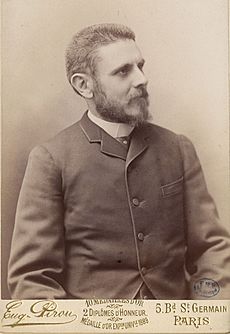Pierre Marie facts for kids
Quick facts for kids
Pierre Marie
|
|
|---|---|

Pierre Marie
|
|
| Born | 9 September 1853 Paris
|
| Died | 13 April 1940 (aged 86) |
| Known for | acromegaly, Charcot–Marie–Tooth disease, physical culture |
| Scientific career | |
| Fields | neurologist endocrinology |
| Institutions | Salpêtrière SFIO |
| Influences | Jean-Martin Charcot |
Pierre Marie (born September 9, 1853, died April 13, 1940) was a famous French doctor who specialized in the brain and nerves. He was known as a neurologist. He also wrote for newspapers and was involved in politics, especially with a group called the SFIO.
Contents
Medical Discoveries
After finishing medical school, Pierre Marie worked as an assistant to another well-known neurologist, Jean-Martin Charcot. This was at the Salpêtrière and Bicêtre Hospitals in Paris. In 1883, he earned his medical degree. He later became a professor, first teaching about diseases and then about neurology. In 1911, he became a member of a respected medical academy in France.
Understanding Diseases
One of Pierre Marie's important discoveries was describing a condition called acromegaly. This disease affects the pituitary gland, a small part of your brain that controls growth. His work helped doctors understand more about how hormones affect the body. This was a big step in a new field called endocrinology, which studies hormones.
He also described other conditions, including a bone and joint disease linked to lung problems, and a condition affecting bones in the skull and collarbone. He also studied aphasia, which is a problem with language that happens after brain injury. His ideas about language problems were different from what many doctors believed at the time. In 1907, he was the first to describe foreign accent syndrome, where someone suddenly starts speaking with a different accent after a brain injury.
Pierre Marie helped start the French Society of Neurology. He also co-founded a medical journal called Revue neurologique. His name is part of a disease called Charcot–Marie–Tooth disease. This condition affects the nerves and causes muscles in the arms and feet to slowly get weaker. It's named after him, Jean-Martin Charcot, and Howard Henry Tooth.
Many doctors learned from Pierre Marie. This included Spanish neurologists Nicolás Achúcarro and Gonzalo Rodríguez Lafora. They were important students of another famous scientist, Santiago Ramón y Cajal.
Political Involvement
Later in his life, around 1928, Pierre Marie started writing more about politics. He first wrote for a magazine about physical culture, which means exercise and fitness. He often wrote about how important exercise was and gave advice on fitness. He also shared his thoughts on government policies about sports and leisure.
Promoting Health and Sports
In 1930, he began writing for a socialist newspaper called Le Populaire. He became more involved with the SFIO, which was a socialist political party. He became known as their main expert on sports, leisure, and physical health.
In 1934, he wrote a pamphlet called "Pour Le Sport Ouvrier" (For Workers' Sports). The SFIO party adopted this as their official policy. This was the first time the party officially supported physical culture. After a political group called the French Popular Front was elected in 1936, Pierre Marie worked as an advisor. He strongly supported sports for working-class people and public health.
Historians have different ideas about when Pierre Marie died. Some records show he passed away before a certain historical period. However, some historians have found writings by him from later years, which has led to discussions about his political views at that time.
Diseases Named After Him
Several medical conditions are named after Pierre Marie because of his important work:
- Marie's ataxia: A genetic disease that affects the nervous system, causing problems with balance and coordination.
- Marie's anarthria: When someone cannot speak clearly because of brain damage.
- Marie–Strümpel Disease: Also known as ankylosing spondylitis. This is a severe type of arthritis that affects the spine, making it stiff. It's also named after German neurologist Adolph Strümpell.
- Marie-Léri syndrome: A hand problem where the bones in the fingers wear away. It's named with neurologist André Léri.
- Bamberger-Marie disease: Also called hypertrophic pulmonary osteoarthropathy. This condition causes swelling and pain in the joints, often linked to lung problems. It's named with Austrian doctor Eugen von Bamberger.
His Writings
Pierre Marie wrote many medical and political books and articles.
Medical Writings:
- Des formes frustes de la maladie de Basedow (1883) - His doctoral thesis on Basedow's disease.
- Sur deux cas d’acromégalie (1886) - About two cases of acromegaly.
- Sur une form particulière d'atrophie musculaire progressive; souvent familiale, débutant par les pieds et les jambes et atteignant tard les mains (1886) - With Jean Martin Charcot, about a type of muscle wasting disease.
- "Essays on Acromegaly" (1891) - A collection of essays on acromegaly.
- Leçons sur les maladies de la moëlle épinière (1892) - Lessons on diseases of the spinal cord.
- Sur l'hérédo-ataxie cérébelleuse (1893) - About inherited cerebellar ataxia.
- L’évolution du langage considéré au point de vue de l’étude de l’Aphasie (1897) - About the evolution of language and the study of aphasia.
- Dysostose cléido-crânienne héréditaire (1897) - With Paul Sainton, about inherited cleidocranial dysostosis.
- Spondylose rhizomélique (1898) - About rhizomelic spondylosis.
- Neurologie (1923) - A two-volume work on neurology.
Political Writings:
- Force et Santé Pour Tous, ou Le Triomphe de La Culture Physique (1928) - Strength and Health for All, or The Triumph of Physical Culture.
- Pour La Santé du Sédentaire (1931) - For the Health of Sedentary People.
- Pour Le Sport Ouvrier (1934) - For Workers' Sports.
See also
- A Clinical Lesson at the Salpêtrière

